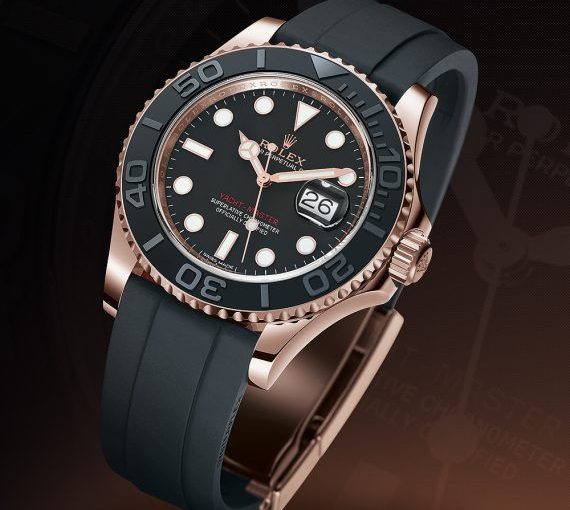In this feature from the WatchTime archives, we take a close look at the modern version of Replica Rolex Oyster Perpetual Yacht-Master, with black Cerachrom bezel and Oysterflex bracelet. Original photos are by Nik Schölzel.

A water-resistant Oyster case, large hour markers and bold hands are essential elements of Replica Rolex Submariner, introduced in 1953 and made for use underwater. In contrast, Rolex’s Yacht-Master, launched in 1992, is a luxury liner – equally at home on board a yacht on the high seas or on land at a ritzy yacht club.
The Yacht-Master was the first watch in Rolex’s Professional Oyster Collection to come in three different case sizes: 29, 35 and 40 mm. The model we tested, launched last year, is offered in two sizes: 37 and 40 mm. We chose the larger version, which we measured at precisely 40.19 mm in diameter and 11.49 mm in height (excluding the magnifying “Cyclops” lens for the date).
The well-known Cyclops date lens was patented by Rolex in 1953 and introduced in 1954 on the Datejust. This magnifying device is made of sapphire, like the watch’s crystal, and has nonreflective coating on both sides. The jumping date advances exactly at midnight.

The watch is powered by a seasoned caliber, the Rolex 3135, used in the very first Yacht-Master in 1992. The 3135 debuted in 1988 in the Submariner. The blue Parachrom balance spring was added to the movement in 2005, five years after it was first introduced in the Cosmograph Daytona. Its paramagnetic alloy resists changes caused by temperature variations and magnetic fields.
The Parachrom balance spring is thinner than a human hair and up to 10 times more resistant to shocks than a conventional balance spring. Provided with an overcoil, it is attached to a large balance wheel with a variable moment of inertia. Fine adjustments are made using four gold Microstella regulating screws. The balance wheel is supported by a height-adjustable bridge. The entire construction ensures rate results that bring the Yacht-Master (as well as the other watches in the Oyster collection) to the rank of “Superlative Chronometer Officially Certified.” These words on the Yacht-Master’s dial mean that the watch has endured 15 days and nights of testing by COSC in addition to a series of tests conducted by Rolex in its own laboratory. Acceptable rate results for a Superlative Chronometer allow deviations of less than +/-2 seconds per day, while COSC’s test permits average deviations between -4 and +6 seconds per day. In addition, Rolex’s tests are carried out under conditions that correspond more closely to real-life situations than COSC’s tests and are conducted on fully assembled watches, while COSC tests just the movements.

The tests performed by Rolex include a water-resistance check. Unlike the Submariner, the Yacht-Master’s water resistance is “only” 100 meters. This means that the Yacht-Master is not designed to be a professional replica watch, which requires water resistance of at least 200 meters.

The Yacht-Master’s bidirectional bezel also keeps it from being a dive watch. The bezel on a dive watch usually rotates in only one direction so it won’t show a shorter dive time if it’s repositioned inadvertently. But the Yacht-Master’s bezel is impressive: it has 120 ratchets and shows graduations in 5-minute increments using both Arabic numerals and line markers. The first quarter has well-defined minutes markers. Polished, raised graduations on the ceramic inlay stand in relief against a sandblasted, matte black background. The bezel is made of Cerachrom, Rolex’s ceramic material. The Ceramic inlay is set in a deeply grooved ring made of Everose gold, Rolex’s rose-gold alloy. A grooved caseback seals the case hermetically and can only be opened using a special tool. Three dots on the screw-down crown indicate that this watch has been sealed with the Triplock sealing system, a triple water- resistance system developed by Rolex.
The screw-down crown sits securely inside the case between two crown guards. Releasing the crown allows it to spring away from the midsection, which makes it easy to use for manual winding, rapid date change and setting the hands.
The dial has a characteristic Rolex look. The applied markers and elongated triangle at 12 o’clock are filled with Rolex’s luminous substance, Chromalight, and are displayed on a matte black background. The hour hand has a “Mercedes” circle filled with Chromalight and the seconds hand has a luminous Chromalight dot. The stark contrast of black and white ensures excellent legibility during the day; at night the Chromalight emits a blue glow for easy reading in the dark.

This watch is the first Rolex with an Oysterflex bracelet. (We use the term “bracelet” rather than “strap” because the Oysterflex, unlike standard rubber straps, has metal on the inside.) Combining a rubber strap with a gold case is nothing new, but at Rolex, known for its conservative approach to design, it’s a major innovation. The patented bracelet has a core made of nickel-titanium alloy blades, which provide excellent flexibility and are coated with a black elastomer, a synthetic type of rubber. When the material is subjected to tension and pressure, it returns to its original shape quickly. It resists environmental changes and is long lasting, waterproof and hypoallergenic – a good alternative to a metal bracelet. The bracelet’s black color goes well with the ceramic bezel and with the Everose gold case, presenting a modern, two-tone look.
Inside the bracelet is a patented cushioning system that increases wearing comfort. The bracelet accommodates changes in wrist size. The single-sided Oysterlock folding clasp made of Everose gold offers additional flexibility; it allows for three length adjustments. Screws attach the clasp securely to the bracelet. A safety bar makes opening the clasp more difficult but prevents it from opening accidentally.
